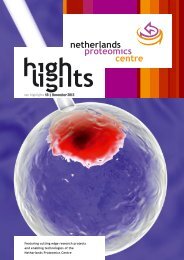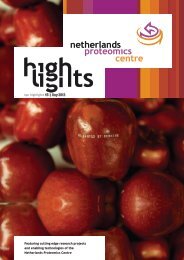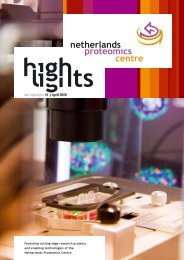NPC Valorisation Voucher - Netherlands Proteomics Centre
NPC Valorisation Voucher - Netherlands Proteomics Centre
NPC Valorisation Voucher - Netherlands Proteomics Centre
Create successful ePaper yourself
Turn your PDF publications into a flip-book with our unique Google optimized e-Paper software.
What this research is about:Just a few thousand cells neededfor high quality analysisAnalysing just a single cell among thousands of others is theholy grail of proteomics nowadays. It would certainly help indiagnosing cancer, for example. The study of cell-to-cell communicationwould also greatly benefit from such an approach.Current proteomics research requires hundreds of thousandsor even millions of cells per sample. Common methods forpeptides analysis using mass spectrometry need these amountsto accurately identify large numbers of peptides.Serena Di Palma spent her PhD study finding new peptideseparation strategies and, more importantly, miniaturisingthose systems, with the aim of developing analytical methodsthat use small sample sizes. She replaced the commonlyused chromatographic separation method known as SCX(strong-cation exchange) with a different chromatographicmethod only recently introduced in proteomics called HILIC(hydrophilic interaction liquid chromatography). HILICseparates peptides mainly by hydrophilicity and to a lesserextent by charge. “This means that peptides do not elute inbig clumps (clusters of similar charge) but more separated,”says Di Palma. Separating hydrophilic peptides has becomemore important in the last years because the interest ofproteomics has shifted towards analysis of post-translationalmodifications of proteins. These are usually polar modificationssuch as glycosylation and phosphorylation, generatingsamples with a large amount of hydrophilic peptides.Di Palma designed a miniaturised set-up using a zwitterionicHILIC, as the peptide fractionation step, combined withreversed-phase (RP) chromatography in a 2D system. “Havingzwitterionic stationary phases means that the total chargeof the material will remain zero, which gives a specialadvantage for analyses performed at different pH values,”says Di Palma. She compared her results to a traditional proteomicsanalysis and found that many more proteins couldbe identified using the HILIC separation step before applyingthe RP chromatography. The protein identification matchedresults from large scale proteomics analysis. The researchersthink that this method can be very useful for analysing smallsamples obtained by laser microdissection or flow cytometry.| 17<strong>NPC</strong> E1: <strong>NPC</strong> New T2: Separation Proteome and Biology Enrichment of Plants Tools in <strong>Proteomics</strong>In our laboratory, we successfully designed a two-dimensional(2D) system based on the combination of zwitterionic HILICand RP, both in nanoscale format [5]. One of the major issuesassociated with the combination of HILIC and RP arises fromthe incompatibility of the mobile phases when employing anon-line setup. To overcome this problem, we refined and miniaturisedour HILIC system, as schematically shown in Figure 1,employing column dimensions as small as 75 µm in the internaldiameter. During the ZIC-cHILIC elution, fractions are directlycollected into a 96-well plate already containing an acidifiedwater solvent. The HILIC fractions are then sufficiently aqueousand compatible with the subsequent RP analysis, withoutfurther manipulation. This strategy could also be defined asin-line, as it is optimised to reduce sample handling, whichFigure 1 | Schematic of the 2D system based on a ZIC-cHILIC fractionation, followed by RP-MS analysis.






